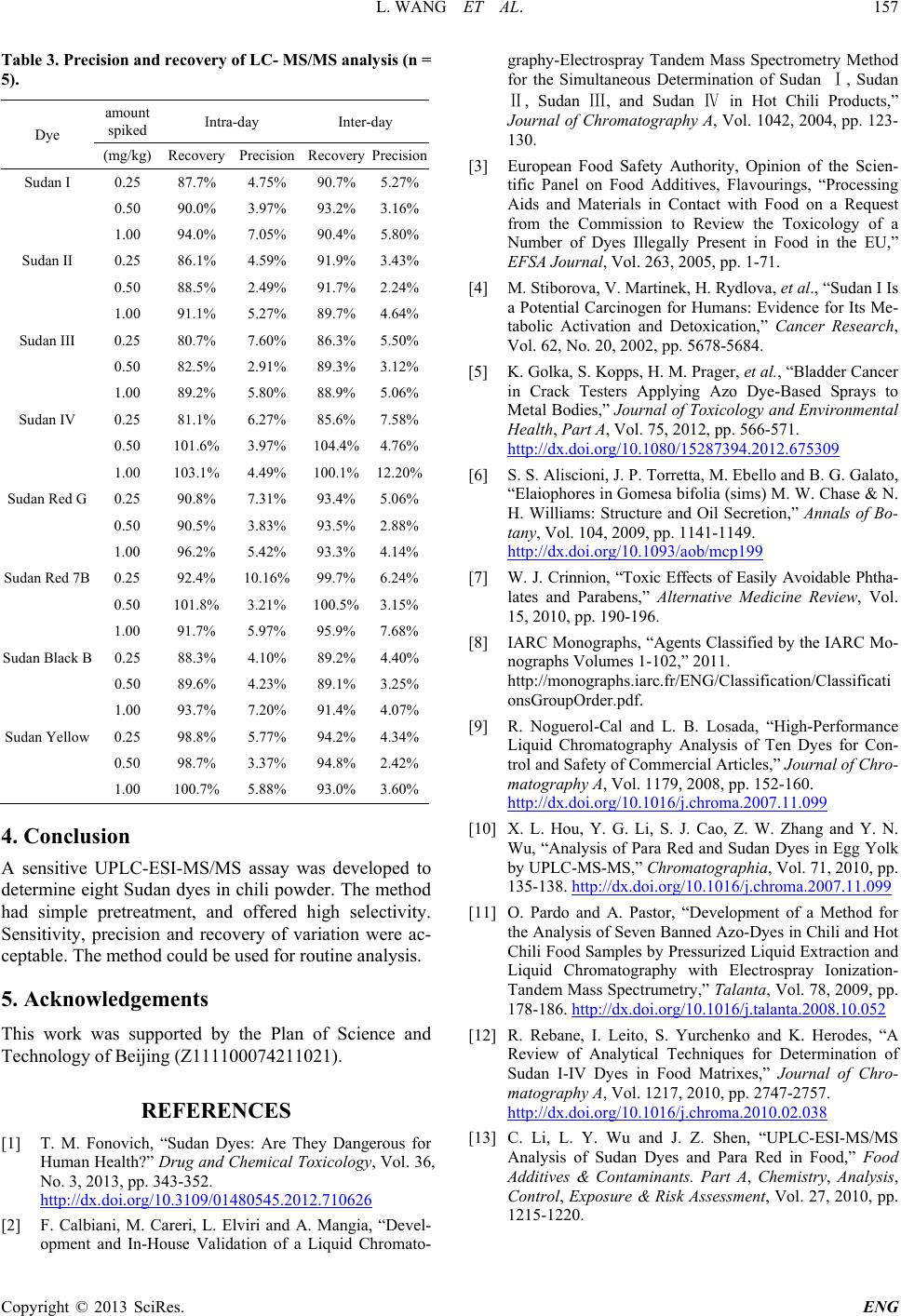
L. WANG ET AL.
Copyright © 2013 SciRes. ENG
Table 3. Precision and recovery of LC- MS/MS analysis (n =
5).
Dye
amount
spiked Intra-day Inter-day
(mg/kg) Recovery Precision Recovery Precision
Sudan I 0.25 87.7% 4.75% 90.7% 5.27%
0.50 90.0% 3.97% 93.2% 3.16%
1.00 94.0% 7.05% 90.4% 5.80%
Sudan II 0.25 86.1% 4.59% 91.9% 3.43%
0.50 88.5% 2.49% 91.7% 2.24%
1.00 91.1% 5.27% 89.7% 4.64%
Sudan III 0.25 80.7% 7.60% 86.3% 5.50%
0.50 82.5% 2.91% 89.3% 3.12%
1.00 89.2% 5.80% 88.9% 5.06%
Sudan IV 0.25 81.1% 6.27% 85.6% 7.58%
0.50 101.6% 3.97% 104.4% 4.76%
1.00 103.1% 4.49% 100.1% 12.20%
Sudan Red G 0.25 90.8% 7.31% 93.4% 5.06%
0.50 90.5% 3.83% 93.5% 2.88%
1.00 96.2% 5.42% 93.3% 4.14%
Sudan Red 7B 0.25 92.4% 10.16% 99.7% 6.24%
0.50 101.8% 3.21% 100.5% 3.15%
1.00 91.7% 5.97% 95.9% 7.68%
Sudan Black B
0.25 88.3% 4.10% 89.2% 4.40%
0.50 89.6% 4.23% 89.1% 3.25%
1.00 93.7% 7.20% 91.4% 4.07%
Sudan Yellow 0.25 98.8% 5.77% 94.2% 4.34%
0.50 98.7% 3.37% 94.8% 2.42%
1.00 100.7% 5.88% 93.0% 3.60%
4. Conclusion
A sensitive UPLC-ESI-MS/MS assay was developed to
determine eight Sudan dyes in chili powder. The method
had simple pretreatment, and offered high selectivity.
Sensitivity, precision and rec ov ery of variation were ac-
ceptable. The method could be used for routine analysis.
5. Acknowledgements
This work was supported by the Plan of Science and
Technology of Beijing (Z111100074211021).
REFERENCES
[1] T. M. Fonovich, “Sudan Dyes: Are They Dangerous for
Human Health?” Drug and Chemical Toxicology, Vol. 36,
No. 3, 2013, pp. 343-352.
http://dx.doi.org/10.3109/01480545.2012.710626
[2] F. Calbiani, M. Careri, L. Elviri and A. Mangia, “Devel-
opment and In-House Validation of a Liquid Chromato-
graphy-Electrospray Tandem Mass Spectrometry Method
for the Simultaneous Determination of Sudan Ⅰ, Sudan
Ⅱ, Sudan Ⅲ, and Sudan Ⅳ in Hot Chili Products,”
Journal of Chromatography A, Vol. 1042, 2004, pp. 123-
130.
[3] European Food Safety Authority, Opinion of the Scien-
tific Panel on Food Additives, Flavourings, “Processing
Aids and Materials in Contact with Food on a Request
from the Commission to Review the Toxicology of a
Number of Dyes Illegally Present in Food in the EU,”
EFSA Journal, Vol. 263, 2005, pp. 1-71.
[4] M. Stiborova, V. Martinek, H. Rydlova, et al., “Sudan I Is
a Potential Carcinogen for Humans: Evide nce for Its Me-
tabolic Activation and Detoxication,” Cancer Research,
Vol. 62, No. 20, 2002, pp. 5678-5684.
[5] K. Golka, S. Kopps, H. M. Prager, et al ., “Bladder Cancer
in Crack Testers Applying Azo Dye-Based Sprays to
Metal Bodies,” Journal of Toxicology and Environmental
Health, Part A, Vol. 75, 2012, pp. 566-571.
http://dx.doi.org/10.1080/15287394.2012.675309
[6] S. S. Aliscioni, J. P. Torretta, M. Ebello and B. G. Galato,
“Elaiophores in Gomesa bifolia (sims) M. W. Chase & N.
H. Williams: Structure and Oil Secretion,” Annals of Bo-
tany, Vol. 104, 2009, pp. 1141-1149.
http://dx.doi.org/10.1093/aob/mcp199
[7] W. J. Crinnion, “Toxic Effects of Easily Avoidable Phtha-
lates and Parabens,” Alternative Medicine Review, Vol.
15, 2010, pp. 190-196.
[8] IARC Monographs, “Agents Classified by the IARC Mo-
nographs Volumes 1-102,” 2011.
http://monographs.iarc.fr/ENG/Classification/Classificati
onsGroupOrder.pdf.
[9] R. Noguerol-Cal and L. B. Losada, “High-Performance
Liquid Chromatography Analysis of Ten Dyes for Con-
trol and Safety of Commercial Arti c les,” Journal of Chro-
matography A, Vol. 1179, 2008, pp. 152-160.
http://dx.doi.org/10.1016/j.chroma.2007.11.099
[10] X. L. Hou, Y. G. Li, S. J. Cao, Z. W. Zhang and Y. N.
Wu, “Analysis of Para Red and Sudan Dyes in Egg Yolk
by UP L C-MS-MS,” Chromatographia, Vol. 71, 2010, pp.
135-138. http://dx.doi.org/10.1016/j.chroma.2007.11.099
[11] O. Pardo and A. Pastor, “Development of a Method for
the Analysis of Seven Banned Azo-Dyes in Chili and Hot
Chili Food Samples by Pressurized Liquid Extraction and
Liquid Chromatography with Electrospray Ionization-
Tandem Mass Spectrumetry,” Talanta, Vol. 78, 2009, pp.
178-186. http://dx.doi.org/10.1016/j.talanta.2008.10.052
[12] R. Rebane, I. Leito, S. Yurchenko and K. Herodes, “A
Review of Analytical Techniques for Determination of
Sudan I-IV Dyes in Food Matrixes,” Journal of Chro-
matography A, Vol. 1217, 2010, pp. 2747-2757.
http://dx.doi.org/10.1016/j.chroma.2010.02.038
[13] C. Li, L. Y. Wu and J. Z. Shen, “UPLC-ESI-MS/MS
Analysis of Sudan Dyes and Para Red in Food,” Food
Additives & Contaminants. Part A, Chemistry, Analysis,
Control, Exposure & Risk Assessment, Vol. 27, 2010, pp.
1215-1220.